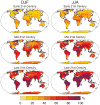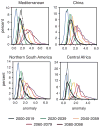Observational and model evidence of global emergence of permanent, unprecedented heat in the 20(th) and 21(st) centuries
- PMID: 22707810
- PMCID: PMC3374649
- DOI: 10.1007/s10584-011-0112-y
Observational and model evidence of global emergence of permanent, unprecedented heat in the 20(th) and 21(st) centuries
Abstract
Given the severe impacts of extreme heat on natural and human systems, we attempt to quantify the likelihood that rising greenhouse gas concentrations will result in a new, permanent heat regime in which the coolest warm-season of the 21(st) century is hotter than the hottest warm-season of the late 20(th) century. Our analyses of global climate model experiments and observational data reveal that many areas of the globe are likely to permanently move into such a climate space over the next four decades, should greenhouse gas concentrations continue to increase. In contrast to the common perception that high-latitude areas face the most accelerated response to global warming, our results demonstrate that in fact tropical areas exhibit the most immediate and robust emergence of unprecedented heat, with many tropical areas exhibiting a 50% likelihood of permanently moving into a novel seasonal heat regime in the next two decades. We also find that global climate models are able to capture the observed intensification of seasonal hot conditions, increasing confidence in the projection of imminent, permanent emergence of unprecedented heat.
Figures




References
-
- Poumadere M, et al. The 2003 heat wave in France: Dangerous climate change here and now. Risk Analysis. 2005;25(6):1483–1494. - PubMed
-
- Patz JA, et al. Impact of regional climate change on human health. Nature. 2005;438(7066):310–317. - PubMed
-
- Battisti DS, Naylor RL. Historical Warnings of Future Food Insecurity with Unprecedented Seasonal Heat. Science. 2009;323(5911):240–244. - PubMed
Grants and funding
LinkOut - more resources
Full Text Sources
